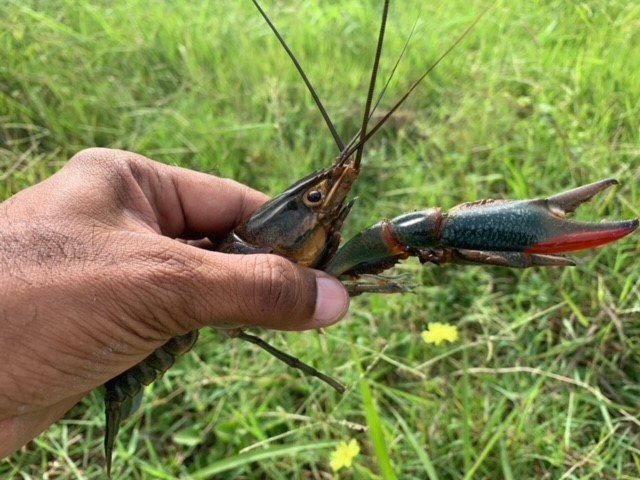Invasive Australian Redclaw Crayfish found in pond at apartment complex in Texas


Researchers from the University of Texas Rio Grande Valley recently collected invasive Australian Redclaw Crayfish (Cherax quadricarinatus) at the first known site in Texas. From January–February, three specimens were collected at an apartment complex pond that connects to a nearby resaca in the Brownsville area.
An earlier 2013 sighting of a female crayfish of this species with several young was also identified on iNaturalist, indicating this species has been present at this location for some time. This is just the second detection of this species in the wild in the United States with the other being in California.
Texas Parks and Wildlife Department (TPWD) Aquatic Biologist Dr. Archis Grubh surveyed numerous sites in the area during July and found three additional Australian Redclaw Crayfish between the apartment pond and a nearby resaca two miles away.
[SCROLL BREAK!!! Bayou Beat News can also be found in PRINT at a store near you. Click the link below to check out our E-Edition!]
“We don’t know when these invasive crayfish were first introduced or how far they have spread, but we do know they can have a negative effect on local species and biodiversity,” said Grubh. “Spreading the word about this invasive species and reporting sightings to TPWD can help us better understand where it is distributed and potentially take steps to help prevent its spread.”
Both male and female Australian Redclaw Crayfish have been collected, so the potential for reproduction is a concern in these waterbodies. The species can reproduce prolifically, with females brooding up to five times a year at 1,000 eggs per clutch. Australian Redclaw Crayfish grow rapidly and can reach maximum size, up to two pounds, in under a year. These large crayfish can significantly alter habitat and vegetation, competitively exclude native crayfish, and impact native fish communities by direct predation. Australian Redclaw Crayfish can also carry Crayfish Plague as well as other parasites/diseases that could impact native crayfish.
Australian Redclaw Crayfish, along with all other members of the crayfish Family Parastacidae, are prohibited exotic species in Texas and cannot be legally purchased, sold or possessed in aquariums. It’s also illegal to release these crayfish into a public waterbody.
“Release of aquarium life is unfortunately a key means by which invasive species such as these crayfish are introduced,” said Monica McGarrity, TPWD Senior Scientist for Aquatic Invasive Species. “Well-meaning, uninformed aquarium owners sometimes release their pets thinking they’re doing the best thing for them, but if they do survive, they can become invasive and harm the native aquatic species and ecosystem. Aquarium owners should research alternatives to aquarium dumping and help prevent introductions of the next invasive species.”
Australian Redclaw Crayfish are identifiable by their large size, large left claws with a red patch on the outer edge and the presence of four distinct ridges on the top of the head. Their preferred habitat includes slow-moving streams and stagnant water bodies (e.g., oxbows and resacas) with high turbidity. They are mobile over moist terrestrial vegetation and can move between waterbodies. The introduction to new areas increases with seasonal rainfall that can wash the crayfish across waterbodies.
Sightings of Australian Redclaw Crayfish should be reported to TPWD by emailing photos and location information to aquaticinvasives@tpwd.texas.gov.
To learn more about alternatives to release of aquarium life, visit the Never Dump Your Tank website.
